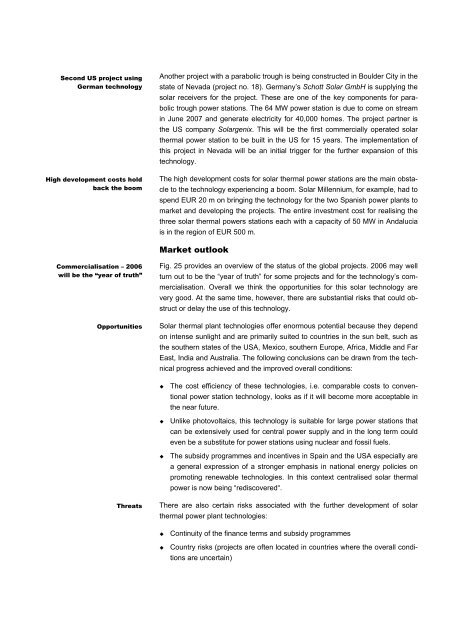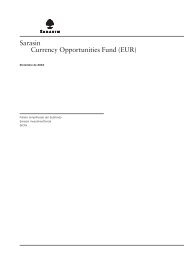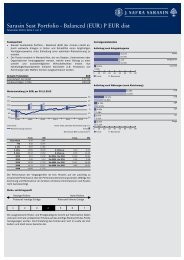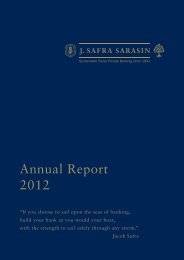Sustainability Report - Bank Sarasin-Alpen
Sustainability Report - Bank Sarasin-Alpen
Sustainability Report - Bank Sarasin-Alpen
You also want an ePaper? Increase the reach of your titles
YUMPU automatically turns print PDFs into web optimized ePapers that Google loves.
Second US project using<br />
German technology<br />
High development costs hold<br />
back the boom<br />
Another project with a parabolic trough is being constructed in Boulder City in the<br />
state of Nevada (project no. 18). Germany’s Schott Solar GmbH is supplying the<br />
solar receivers for the project. These are one of the key components for parabolic<br />
trough power stations. The 64 MW power station is due to come on stream<br />
in June 2007 and generate electricity for 40,000 homes. The project partner is<br />
the US company Solargenix. This will be the first commercially operated solar<br />
thermal power station to be built in the US for 15 years. The implementation of<br />
this project in Nevada will be an initial trigger for the further expansion of this<br />
technology.<br />
The high development costs for solar thermal power stations are the main obstacle<br />
to the technology experiencing a boom. Solar Millennium, for example, had to<br />
spend EUR 20 m on bringing the technology for the two Spanish power plants to<br />
market and developing the projects. The entire investment cost for realising the<br />
three solar thermal powers stations each with a capacity of 50 MW in Andalucia<br />
is in the region of EUR 500 m.<br />
Market outlook<br />
Commercialisation – 2006<br />
will be the “year of truth”<br />
Opportunities<br />
Fig. 25 provides an overview of the status of the global projects. 2006 may well<br />
turn out to be the “year of truth” for some projects and for the technology’s commercialisation.<br />
Overall we think the opportunities for this solar technology are<br />
very good. At the same time, however, there are substantial risks that could obstruct<br />
or delay the use of this technology.<br />
Solar thermal plant technologies offer enormous potential because they depend<br />
on intense sunlight and are primarily suited to countries in the sun belt, such as<br />
the southern states of the USA, Mexico, southern Europe, Africa, Middle and Far<br />
East, India and Australia. The following conclusions can be drawn from the technical<br />
progress achieved and the improved overall conditions:<br />
<br />
<br />
<br />
The cost efficiency of these technologies, i.e. comparable costs to conventional<br />
power station technology, looks as if it will become more acceptable in<br />
the near future.<br />
Unlike photovoltaics, this technology is suitable for large power stations that<br />
can be extensively used for central power supply and in the long term could<br />
even be a substitute for power stations using nuclear and fossil fuels.<br />
The subsidy programmes and incentives in Spain and the USA especially are<br />
a general expression of a stronger emphasis in national energy policies on<br />
promoting renewable technologies. In this context centralised solar thermal<br />
power is now being “rediscovered“.<br />
Threats<br />
There are also certain risks associated with the further development of solar<br />
thermal power plant technologies:<br />
<br />
<br />
Continuity of the finance terms and subsidy programmes<br />
Country risks (projects are often located in countries where the overall conditions<br />
are uncertain)
















